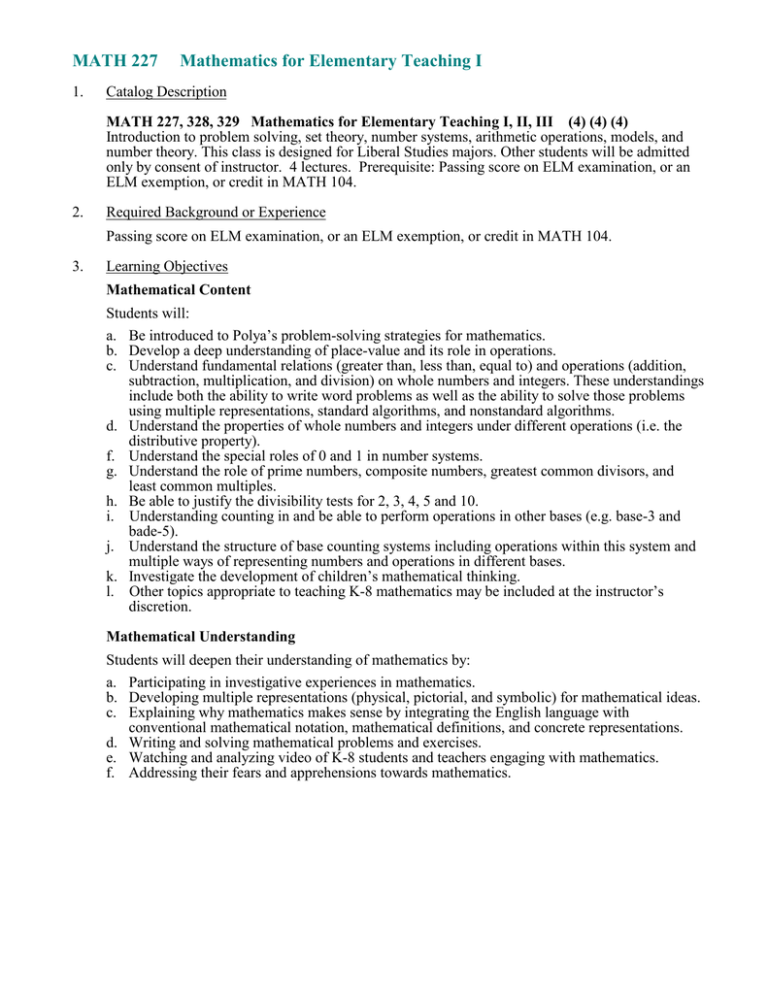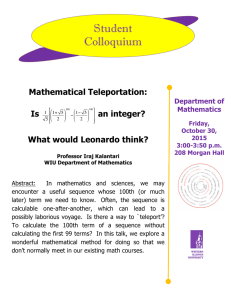MATH 227 Mathematics for Elementary Teaching...
advertisement

MATH 227 1. Mathematics for Elementary Teaching I Catalog Description MATH 227, 328, 329 Mathematics for Elementary Teaching I, II, III (4) (4) (4) Introduction to problem solving, set theory, number systems, arithmetic operations, models, and number theory. This class is designed for Liberal Studies majors. Other students will be admitted only by consent of instructor. 4 lectures. Prerequisite: Passing score on ELM examination, or an ELM exemption, or credit in MATH 104. 2. Required Background or Experience Passing score on ELM examination, or an ELM exemption, or credit in MATH 104. 3. Learning Objectives Mathematical Content Students will: a. Be introduced to Polya’s problem-solving strategies for mathematics. b. Develop a deep understanding of place-value and its role in operations. c. Understand fundamental relations (greater than, less than, equal to) and operations (addition, subtraction, multiplication, and division) on whole numbers and integers. These understandings include both the ability to write word problems as well as the ability to solve those problems using multiple representations, standard algorithms, and nonstandard algorithms. d. Understand the properties of whole numbers and integers under different operations (i.e. the distributive property). f. Understand the special roles of 0 and 1 in number systems. g. Understand the role of prime numbers, composite numbers, greatest common divisors, and least common multiples. h. Be able to justify the divisibility tests for 2, 3, 4, 5 and 10. i. Understanding counting in and be able to perform operations in other bases (e.g. base-3 and bade-5). j. Understand the structure of base counting systems including operations within this system and multiple ways of representing numbers and operations in different bases. k. Investigate the development of children’s mathematical thinking. l. Other topics appropriate to teaching K-8 mathematics may be included at the instructor’s discretion. Mathematical Understanding Students will deepen their understanding of mathematics by: a. Participating in investigative experiences in mathematics. b. Developing multiple representations (physical, pictorial, and symbolic) for mathematical ideas. c. Explaining why mathematics makes sense by integrating the English language with conventional mathematical notation, mathematical definitions, and concrete representations. d. Writing and solving mathematical problems and exercises. e. Watching and analyzing video of K-8 students and teachers engaging with mathematics. f. Addressing their fears and apprehensions towards mathematics. Math 227, Page 2. 4. Text and References Sowder, J., Sowder, L. & Nickerson, S. (2014). Reconceptualizing Mathematics for Elementary School Teachers, 2nd edition, W.H. Freeman and Co., New York, NY. 5. Minimum Student Materials Required text, and activity materials provided by instructor. 6. Minimum University Facilities Mathematics education classroom equipped with materials and technology. 7. Content and Method Topic Lectures Chapter 1: Reasoning About Quantities 4 1.1 – What is a Quantity? 1.2 - Quantitative Analysis 1.3 - Values of Quantities 1.4 - Issues for Learning: Ways of Thinking About Solving Story Problems Chapter 2: Numeration Systems 2.1 – Ways of Expressing Values of Quantities 2.2 – Place Value 2.3 – Bases Other Than Ten 2.4 – Operations in Different Bases 8 Chapter 3: Understanding Whole Numbers Operations 3.1 – Additive Combinations and Comparisons 3.2 – Ways of Thinking About Addition and Subtraction 3.3 – Children’s Ways of Adding and Subtracting 3.4 – Ways of Thinking About Multiplication 3.5 – Ways of Thinking About Division 3.6 – Children Finding Products and Quotients 13 Chapter 11: Number Theory 11.1 – Factors and Multiples, Primes and Composites 11.2 – Prime Factorization 11.3 – Divisibility Tests to Determine Whether a Number is Prime 11.4 – Greatest Common Factor, Least Common Multiple 11 Total ___ 36 Method Lecture, discussion, and activity. 8. Methods of Assessment Class activities, homework and lab assignments, term projects, midterm tests or quizzes, final examination.





